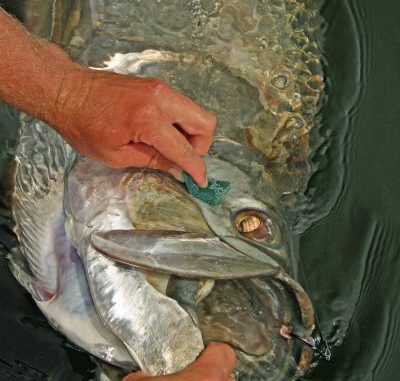
There’s more value to a tarpon release then, well, a released fish. That’s where forensic science offers a new tool for tarpon research — a tool that anglers throughout the Gulf of Mexico can help fisheries managers utilize.
According to Kathy Guindon, fisheries biologist with Florida’s Fish and Wildlife Research Institute, sonic transmitters attached to tarpon have proven that most tarpon survive catch and release. That’s encouraging, but stats on recapture frequency and fish movement would be equally valuable — if they weren’t so scarce.
To this end, Guindon heads up the Tarpon Genetic Recapture Study, a joint research project between FWRI and Mote Marine Laboratory in Sarasota, Fla. In a nutshell, DNA samples taken from captured tarpon are analyzed to determine basic details that may shed some light on what happens after a release.
“Tarpon are hardy fish and the data shows that they do survive after being released,” Guindon said. “The next question was: ‘If most of these fish survive, How many are caught again and where?’ We’re now looking at this so we can start to see the recapture rates and movement.”
The study collects tarpon DNA through dorsal-fin clippings and skin-cell samples obtained from abrasive pads rubbed against a tarpon’s bony check plates. In the interest of tarpon safety, FWRI scientists prefer to handle the fin clips, but recreational anglers provide most of the DNA “scrubs,” along with basic details of catch date, location and fish size. (In boats with more freeboard, anglers often attach a scrub pad to a mop handle for longer reaches.)
A tarpon’s bony cheek plate has no blood vessels, so scrubbing there is a low-impact operation with no risk of infection.
“Genetic tagging is less invasive (than conventional dart tagging),” Guindon said. “It’s no different than if a tarpon rubbed against a rock or ledge under water.
Comparing DNA samples from past and future catches provides a definitive picture of which fish are recaptured. Such information is vital because the tarpon’s highly-migratory ways, plus its extremely challenging nature, makes it a more difficult species to study than other common inshore targets like redfish or speckled trout.
Noting the relatively low level of lifestyle data available for tarpon, Guindon said FWRI is particularly interested in learning more about the fish’s spawning habits. Discovering the species’ annual travel schedules may lead to cross-border management efforts.
“There are a lot of unknowns about tarpon,” Guindon said. “Just because Florida is doing a good job of managing our fisheries, it doesn’t mean that other areas in which these fish are caught are being managed properly.
“For example, we know that tarpon are fished commercially in some Central American waters, so we’d like to know if some of the fish we release in Florida end up getting caught (in those areas).”
The study’s self-explanatory slogan “Any Tarpon, Anywhere, Any Size” describes a more inclusive system than conventional dart tagging — generally reserved for adult tarpon. The DNA method opens the study to more fish and, therefore, more data. FWRI can work up a tarpon DNA sample for about $3 — a more cost-effective use of limited resources.
FWRI provides sampling kits with scrub pads, plastic vials with ethanol for preserving the samples, catch data sheets, pencils and zippered plastic bags for returning the samples to official drop-off sites, or sending to FWRI via the U.S. Postal Service.
For information on genetic tagging, call (800) 367-4461 or email TarponGenetics@myfwc.com.
